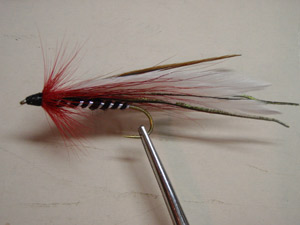Bi-Plane Streamer in 3D
By Chief Needabeh and Nathan Perkinson
A critical eye will discern one major flaw in the design of standard major flaw in the design of standard streamers. Although designed to imitate baitfish, standard streamers are tied flat, in two dimensions. A streamer with saddle-hackle wings looks great from either side, where its height and length come into play, observe the same streamer from below, the angle at which many fish will see your fly and it suddenly becomes a narrow body of wool, silk or tinsel. Those long, flowing wings all but disappear and your brilliant bait fish imitation begins to resemble a swimming candy cane. Many anglers have developed flies that are tied in three dimensions so that fish are presented with an appetizing offering whether it’s these “3D” streamers feature feather wings that are tied flat atop the hook, rather than upright in the typical style, although these streamers have largely been forgotten as historical oddities, they are in fact effective flies that you can use to catch trout, salmon and bass today. 3D streamers were developed to address tough fishing conditions. They are an alternative to the ordinary; simply a representation of the eternal tinkering that defines us as anglers and fly tiers. Chief Needabeh called this fly a bi-plane because the wings are attached in a perpendicular plane to the bend of the hook. You can tie the wing to the body to prevent fouling and maintain the fly’s shape in the water.
Pattern
HOOK - long streamer, sizes 2 to 10
THREAD- Black
RIB - Flat silver tinsel
BODY- black wool
UNDERWING- Red buck tail
WING - six white and one brown saddle hackle, tied flat
SIDES - peacock herl
HACKLE – red, tied fullHow to Tie
- Debarb hook- mount hook in vise- select six white saddle hackles and one brown. Strip hackles to a length slightly longer than the hook (one and half the gap past bend of the hook), stack the feathers with the brown one on top and secure with a drop of head cement near the bare hackle stems. Set the wing aside to dry.
- Start your thread about mid shank wrap backward about three quarters of the hook shank then tie in your silver tinsel ribbing. And dub the wool to make a straight (not tapered) body ending just about an eyelet from the eye (don’t crowd the head) wrap the tinsel forward for the ribbing and tie off and clip the tag ends off.
- Level the head with several wraps of thread to ensure the wing lies flat then tie in several strands of red bucktail as an underwing. (about one gap length past the bend of the hook)
- Lay the wing assembly flat on top of the fly and secure with a few loose wraps just behind the head and in front of the body (a gap and a half past the bend of the hook). When you get the wing in position bind it down with several firm wraps, clip the hackle stems and add a drop of head cement.
- Tie in a pair of peacock herls just behind the head and in front of the body on each side of the streamer (two gap lengths past the bend of the hook).
- Tie in one red hackle just behind the head and in front of the body and wind a full collar. Build a neat tapered head, whip finish and cement.
REMEMBER CPR
CATCH – PICTURE - RELEASE


